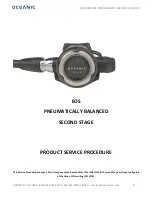
Bronkhorst®
Instruction Manual EL-PRESS™
9.17.101I
19
3
Operation
After correct installation of the
EL-PRESS™
and when all safety precautions have been taken into account, the instrument
can be used for measuring/ controlling pressure in the system.
3.1
Powering up and powering down
·
It is recommended to turn on power before applying fluid pressure and to switch off power only after relieving fluid
pressure.
·
For best performance of a
pressure controller
: let the instrument warm up for at least 30 minutes before starting
measurement and control.
·
For a
pressure meter
, the warm-up time is negligible.
When applying pressure, avoid pressure shocks and bring the fluid system gradually up to the level of the specified
operating conditions; open the fluid supply gently.
3.2
First use
In systems for use with corrosive or reactive media, purging for at least 30 minutes with a dry, inert gas (like Nitrogen or
Argon) is absolutely necessary before use. After use with corrosive, reactive or hazardous media (e.g. toxic or flammable),
purging is also necessary before the fluid system is exposed to air.
3.3
Pressure measurement and control
When powering up, the instrument needs a couple of seconds
to start up the electronics. As soon as the start-up sequence
has finished (green LED glows continuously), the instrument is
ready for operation.
After powering up, the control valve closes (normally open) or
stays closed (normally closed). The valve stays closed until the
instrument receives a setpoint from the active setpoint source.
The internal PID controller then immediately opens the control
valve, until the measured pressure matches the setpoint. It
maintains the resulting pressure rate until another setpoint is
given.
3.4
Valve Safe State
When a controlling instrument is not powered, the control valve automatically returns to its 'Safe State', which is closed for
a 'normally closed' valve (N.C.) and fully open for a 'normally open' valve (N.O.). See the
specifications to see which valve type is used on your
EL-PRESS™
(if applicable).
Certain events may cause the instrument to fall in to Valve Safe State to protect the system, for instance (fieldbus)
communication errors (see
).
3.5
Manual controls
On top of the housing, the instrument is equipped with two LEDs and a multifunctional switch,
which can be used to monitor the instrument visually and start several functions manually.
3.5.1
LED indications
The LEDs on top of the instrument indicate the operational state. The meaning of some indications depends on the specific
fieldbus interface of the instrument (if installed).
•
(green)
Mode: operation mode indication
•
(red)
Error: error/warning messages
















































